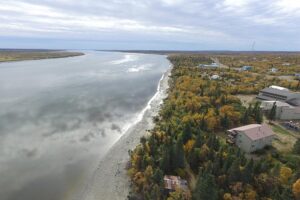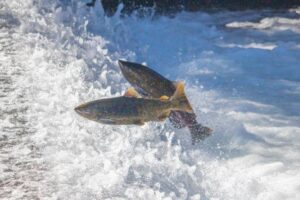For decades, NOAA’s Office of Habitat Conservation has supported habitat restoration efforts across the USA through large-scale competitive funding opportunities and expert technical assistance.
With funding under the Bipartisan Infrastructure Law and Inflation Reduction Act, they are continuing their work to reconnect and revitalize fisheries and coastal communities through habitat restoration and coastal resilience efforts.
Many of these projects are undoing the ecologically destructive work done by the U.S. Army Corps of Engineers over the past century.
This includes:
- Fish passage projects that restore access to healthy habitat for migratory fish;
- Habitat restoration projects that support fisheries and protected species while also strengthening the resilience of coastal ecosystems and communities; and
- Capacity building and on-the-ground restoration projects that advance the coastal habitat restoration priorities of tribes and underserved communities.
Here’s what NOAA says about their work:
Fish Passage
With this funding, NOAA is continuing our work to reopen migratory pathways and restore access to healthy habitat for fish.
A portion of this funding is specifically dedicated to support Indian tribes and Native American organizations that represent Native American tribes in implementing fish passage projects and building tribal organizational capacity.
Every year, millions of fish migrate to their spawning and rearing habitats to reproduce. Some fish need to swim thousands of miles through oceans and rivers to reach their destinations.
They are often blocked from completing their journey by barriers like dams and culverts.
When fish can’t reach their habitat, they can’t reproduce and maintain or grow their populations. As a result, many fish populations have declined. NOAA works to reopen these migratory pathways, restoring access to healthy habitat for fish.
These efforts also provide community and economic benefits, like increased opportunities for fishing and boating and reduced risk of flooding.
Fish Passage Projects
To date, NOAA has announced funding for 36 fish passage projects under the Bipartisan Infrastructure Law.
Learn more about these projects:
Past Funding Opportunities
- Restoring Fish Passage through Barrier Removal Grants
- Restoring Tribal Priority Fish Passage through Barrier Removal Grants
Habitat Restoration and Coastal Resilience

Funding will support the Native Village of Levelock, Alaska, in assessing how future climate scenarios could affect their community. Credit: Rich Buzard/Alaska Division of Geological and Geophysical Surveys.
NOAA is using this funding to invest in transformational habitat restoration and coastal resilience projects across the country.
NOAA has dedicated a portion of this funding specifically to advancing the coastal habitat restoration priorities of tribes and underserved communities, to provide capacity for these communities to more fully participate in restoration activities.
Communities, businesses, and infrastructure in coastal areas are under increasing pressure from the impacts of flooding, climate change, and sea level rise. Habitat restoration provides a safe, effective, and affordable approach to coastal protection.
Efforts like restoring coastal wetlands and reopening rivers to migration help strengthen the resilience of coastal communities and ecosystems while also supporting our nation’s fisheries and protected species.
Capacity building and on-the-ground restoration activities in tribal and underserved communities help to ensure their needs and priorities are at the center of habitat restoration efforts in their communities.
Habitat Restoration and Coastal Resilience Projects
To date, NOAA has announced funding for 73 habitat restoration and coastal resilience projects under the Bipartisan Infrastructure Law with funding leveraged from the Inflation Reduction Act.
Learn more about these projects:
- Transformational habitat restoration and coastal resilience projects
- Coastal habitat restoration and resilience grants for underserved communities
Past Funding Opportunities:
- Transformational Habitat Restoration and Coastal Resilience Grants
- Coastal Habitat Restoration and Resilience Grants for Underserved Communities
Habitat Restoration and NOAA
The NOAA Fisheries Office of Habitat Conservation has a long history conducting habitat restoration efforts with large-scale competitive funding opportunities and expert technical assistance through our Community-based Restoration Program.
Since 1996, the program has partnered with more than 2,600 organizations to take on more than 2,200 projects.
These efforts have restored more than 94,000 acres of habitat and opened up more than 4,400 miles of streams and rivers to fish migration.
Featured photo shows tidal wetland restoration in California. Credit: NOAA Fisheries.


